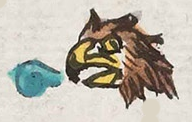Cuauhtlatoa (Mdz6r)
This compound glyph for the personal name Cuauhtlatoa (or Cuauhtlahtoa, with the glottal stop) has two notable elements. One is an eagle's (cuauhtli) head. The other is a speech scroll, emblematic for the verb "to speak" (tlatoa/tlahtoa). The eagle's head has dark brown feathers fading to white near the face. Its eye and beak are yellow (except for the upper tip, which is black). The speech scroll is turquoise blue, and it curls under. The eagle's head is in profile looking to the viewer's left.
Stephanie Wood
Berdan and Anawalt interpret this personal name to mean "Speaking Eagle," which fits what we see, as would "The Eagle Speaks" (a sentence). The definition of tlatoa/tlahtoa also includes the birdsongs, but knowing that cuauhtlatolo refers to military government, because eagles were an elite warrior group, perhaps this name refers to the edicts or war cries of a ranking officer.
Popular belief is that the saint Juan Diego, who witnessed the apparition of the Virgin of Guadalupe, had the name Cuauhtlatoatzin. But other sources mention other, elite, ruling men with the name Quauhtlatoa or Cuauhtlatoa (Cuauhtlahtoa). Chimalpahin described him as the son of Prince Acolmiztli of Tlatelolco, grandson of the King Tlacateotl, and great-grandson of Quaquapitzahuac. He succeeded his grandfather as king, but he was killed by the Tenochca. (Note that the contextualizing image, below, right, shows his eyes closed, which suggests that he is remembered here as deceased already. And he wears a xihuitzolli, a Native crown. He is depicted in the Codex Teleriano-Remensis (folio 33 verso) as a warrior, with a macuahuitl (obsidian-studded club) and a chimalli (shield). In that image, the speech scroll has three curls.
Stephanie Wood
by 1553 at the latest
Stephanie Wood
feathers, plumas, nombres de hombres

cuauh(tli), eagle, https://nahuatl.wired-humanities.org/content/cuauhtli
tlatoa, to speak, https://nahuatl.wired-humanities.org/content/tlatoa-0
"Speaking Eagle" (Berdan and Anawalt, 1992, vol. 1, p. 234)
"El Águila Habla"
Stephanie Wood
Codex Mendoza, folio 6 recto, https://digital.bodleian.ox.ac.uk/objects/2fea788e-2aa2-4f08-b6d9-648c00..., image 22, of 188.
Original manuscript is held by the Bodleian Libraries, University of Oxford, MS. Arch. Selden. A. 1; used here with the UK Creative Commons, “Attribution-NonCommercial-ShareAlike 3.0 License” (CC-BY-NC-SA 3.0)




